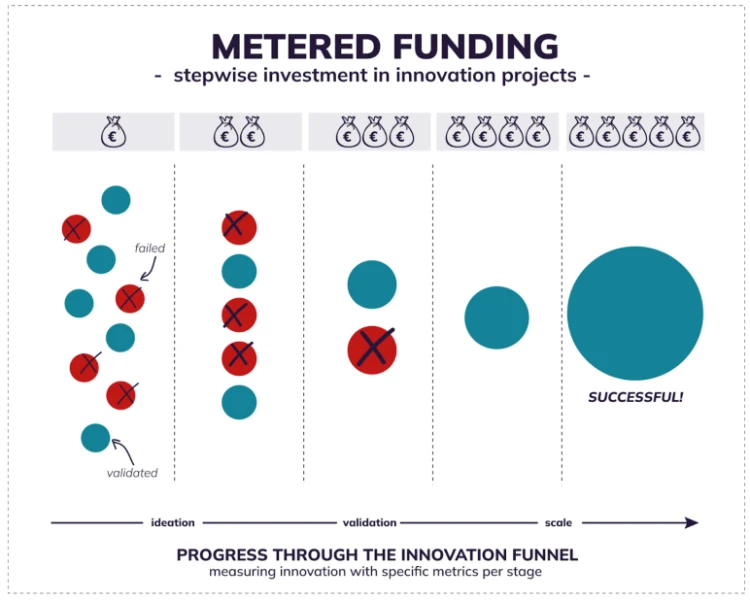In today’s fast-changing world, most organizations acknowledge the necessity of innovation. Customer needs evolve rapidly, demanding businesses to adapt continuously. The debate is no longer about why companies need to innovate, it’s about how to gain more assurance that the efforts and investments in innovation will pay off. A budget can only be spent once, after all.
Predicting the future is always challenging, but innovation takes this uncertainty to another level. Unlike regular business operations, innovation projects also lack historical data that can be used to forecast outcomes. And, this is where measuring innovation, or innovation accounting, comes into play. By implementing tailored methods for tracking and measuring progress, organizations can reduce uncertainty, build confidence in their investments, and make smarter decisions about where and how to innovate.
The importance of innovation accounting
Innovation projects are filled with uncertainties, making traditional financial metrics like ROI unsuitable for evaluating their potential. ROI calculations for early-stage innovation are often nothing more than wild guesses. Moreover, relying on ROI at the start can lead to selecting only projects that are too similar to existing business, killing groundbreaking projects before they even begin. Furthermore, bringing disruptive ideas to market is an iterative process. Experiments are necessary to refine concepts and avoid costly failures. While financial metrics like ROI capture the costs of experimentation, they fail to account for avoided failures and qualitative benefits, such as knowledge gained. That being said, this doesn’t mean that innovation projects should operate with a blank check. Innovation is a business process that requires management and measurement. Tracking progress is essential to determine whether to stop, pivot, or persevere with a project and to justify continued investment.
What is innovation accounting?
Innovation accounting addresses these challenges by using meaningful metrics to evaluate the progress and success of innovation initiatives. It focuses on forward-looking indicators and provides a structured way to assess whether a project is on track. This approach helps organizations make informed decisions throughout the innovation funnel and includes metered funding. Measuring progress continuously, rather than waiting until a project is fully launched, is crucial to avoid costly surprises.

Different kinds of innovation metrics
In an innovation accounting model, there are three levels of metrics, each serving distinct objectives:
- Operational metrics: track the progress of projects throughout the funnel
- Governance metrics: guide management in making data-driven investment decisions, and
- Strategic metrics: evaluate the overall impact on the organization
Within these levels, metrics are further divided into activity and impact metrics. Activity metrics focus on the efforts involved in innovation, such as the number of ideas generated or experiments conducted. In contrast, impact metrics, like conversion rates, measure the outcomes and reflect the translation into tangible business value.
Measuring innovation across stages
As innovation projects progress through different stages, the metrics required to evaluate success shift based on the critical success factors at each stage. They evolve from learning-based to growth-based in latter stages. In the exploration and ideation stages for example, the focus is on understanding customer needs and validating the problem. Metrics like customer interviews and insights gathered are key. During the validation stage, where assumptions are tested, metrics such as customer feedback on prototypes or willingness to pay offer clarity on the project’s potential. As the project moves into scaling, the focus shifts to market fit and financial viability, with metrics like retention rates and revenue per user becoming critical. These stage-specific metrics ensure that both progress is effectively measured and that funding is aligned with the project’s readiness and potential outcomes.
A tailored and flexible approach
Every organization, and even every innovation project, requires a unique set of tailored innovation accounting metrics. This is due to the distinct needs, challenges, strategies, and objectives specific to each company and industry. For example, a tech start-up will require focus on entirely different indicators compared to a pharmaceutical company or a project within the healthcare sector.
Furthermore, an innovation accounting model should be flexible and evolve as the business environment changes. This ensures that the model remains relevant, enabling organizations to make well-founded choices.
Conclusion
Innovation accounting is not about predicting the future; it’s about creating confidence in the innovation process. By measuring progress with meaningful metrics, organizations can ensure that their investments are data-driven and aligned with strategic goals. It enables them to make more confident decisions, pivot when necessary, and innovate with purpose.
Why choose RevelX for innovation management?
At RevelX, we are experts in innovation management and can help your organization navigate the complexities of innovation accounting. Unlike many agencies that focus solely on theory, we specialize in applied innovation management. Our hands-on approach ensures that innovation becomes a core business process in your organization, delivering real and sustainable results.
Whether you need help developing an innovation strategy, designing an innovation operating model, or embedding a culture of innovation, our team has the expertise to support you every step of the way.
Let’s talk
Are you ready to elevate your innovation capabilities? Discover how RevelX can help you achieve sustainable growth through effective innovation management. Contact Us at: rob.nouwens@revelx.nl or make an introduction appointment directly here.
Carla Siebinga
As an energetic and hands-on innovation professional, Carla thrives on turning challenges into creative, actionable solutions. Her working experience in product & business development spans over two decades and at different sides of the table. From working at Philips to co-founding a successful startup and her work as an innovation consultant. This has given her the acumen to get things done in various settings. She fosters building relationships, can be a counterpart at C-level but has the ability to connect at all different levels within an organisation.
Related posts
The power of AI enhanced innovation software
Unique integration of RevelX’ best practices embedded in…
March 12, 2025
Introducing ISO 56001: The new standard in innovation management
ISO 56001 provides organizations with a structured…
January 14, 2025
Manual vs AI-powered subsidies search: A novel approach to public funding
Ever felt like finding the right subsidy feels like…
November 20, 2024



